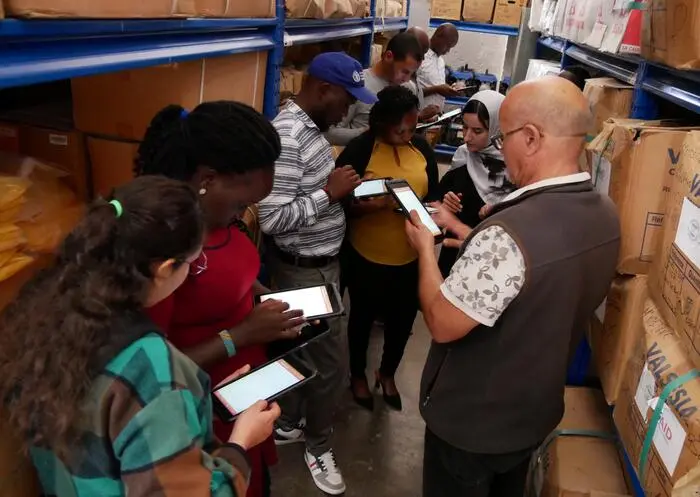The Locust Pesticides Management System enhances locust management and reduces the risks of pesticides to humans and the environment.
When the desert locust upsurge of 2019-2022 occurred in Kenya, Esbon Agira was deployed as a base manager in Marsabit County, north of the country. His work involved surveying desert locusts and provided information to the locust control operation teams.
“Before the desert locust invasion, we were not prepared as a country. The last time Kenya faced the locust invasion of that magnitude was 70 years ago. There were thus no dedicated experts in desert locust management, and we lacked appropriate equipment and adequate pesticides to conduct control operations,” says Esbon.
The impact of the locust upsurge on food security and livelihoods in Kenya was averted thanks to the urgent intervention of the UN Food and Agriculture Organization (FAO) and other partners. The interventions involved using pesticides to spray locusts in the invaded areas.
“After the successful locust control operations, some quantities of unused pesticides and empty containers were left. How were we going to manage the remaining pesticides and dispose of the empty containers?” Esbon wondered.
A safe system to reduce risks of pesticides
Esbon, was one of the experts from Kenya who received the hands-on training in the use of the latest version of the Locust Pesticides Management System (Locust-PMS), developed by FAO for both locust breeding and invasion countries.
The system enables countries to record and monitor the stocks of pesticides available for locust control operations. When effectively implemented, the Locust-PMS reduces the risks of pesticide exposure to human and natural resources.
The team conducted simulation exercises at the Desert Locust Management Centre (CNLAA) in Morocco, where the system has been efficiently operational at the six pesticide stores and two warehouses.
The Locust-PMS training was supported by the FAO-implemented project with financial support from USAID‘s Bureau for Humanitarian Assistance (BHA).
How Locust-PMS works
The system downloaded on tablets is used to register pesticide products, collect data from the quantity of pesticides, useable and obsolete pesticides, spray, survey, empty containers, and safety equipment in the store, to personnel, vehicles, and information and communication systems used in desert locust control and survey operations.
The pesticide database is kept in a cloud where it can be updated and also generate QR codes to keep track of pesticide products and equipment.
Country desert locust control teams can easily access the Locust-PMS application by downloading it from Google Play Store under the name “FAO Locust PMS”.
Better pesticide management practices
The CNLAA centre using the Locust-PMS app proved that with proper information on the stock, the shelf life of pesticides can be extended by analyzing the stock.
“The Locust-PMS enables proper monitoring and quality checks of the pesticide which can allow extension of shelf life, of course with proper storage conditions. The expiry date doesn’t limit usability or viability of the pesticides,” said Barack Eliud Baraka, desert locust Officer, Kenya, providing insights after the 5-day practical training.
“When you have a good register of your stock, it saves time and resources that would have gone into procuring unnecessary pesticide stocks and equipment. It would be even easier to sell the extra stock to other countries through triangulation arrangements,” said Collins Marangu, Director of Plant Protection and Food Safety Directorate in Kenya’s Ministry of Agriculture and Livestock Development. “We are looking forward to making locust management effective in Kenya and enhance our preparedness,” he added.
Triangulation refers to FAO-facilitated arrangements in which a donor funds the repacking and movement of a stock of pesticides from a country that has an excess stock to a country in direct need of the product concerned. If well conducted, FAO believes such arrangements have the potential to decrease excess stocks.
The Locust-PMS replaces the old pesticides management system – Pesticide Stock Management System (PSMS) – also developed by FAO.
Photo Courtesy
